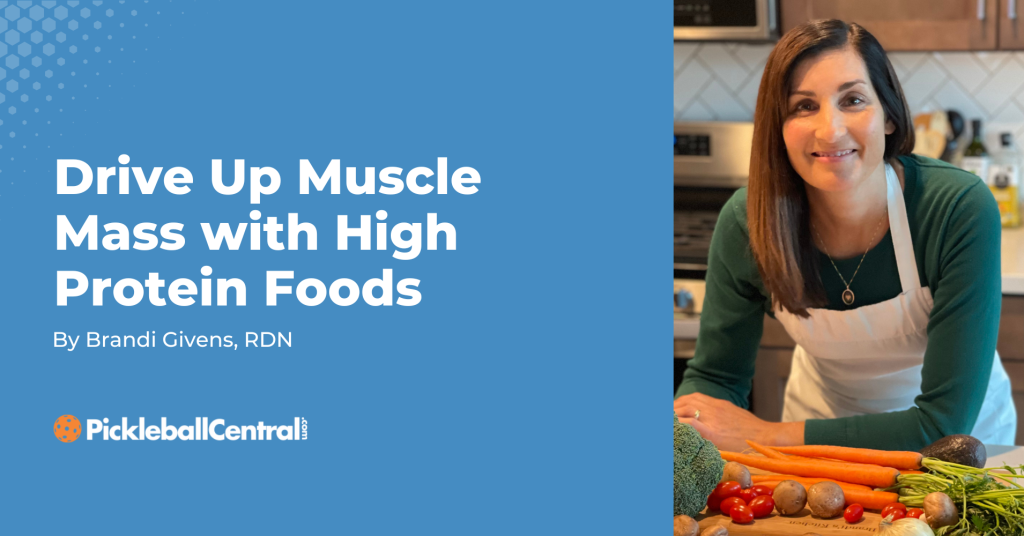By Brandi Givens, RDN
Brandi has been a registered dietitian since 2010 with experience counseling hundreds of clients during her time with the Supplemental Program for Women, Infants, and Children (WIC). Now as a nutrition writer, she hopes to reach an even greater population by sharing well-researched, credible information through her articles.

It’s undeniable that the game of pickleball is changing before our eyes. While it’s still a sport that requires plenty of intellectual finesse shots, higher-level players also need the ability to fire powerful put-aways. And hitting those winners without injury requires strength.
Thankfully there’s a trend toward building lean muscle mass for both men and women. The value of strength training, aka resistance training, is backed by science, and research shows that there are many health benefits to increasing muscle mass.
Athletes who strength train may gain the following benefits:
- Lower risk of injury
- More flexibility
- Improved balance
- Improved cardiovascular health
- Better controlled blood glucose
- Lower abdominal fat
- Osteoporosis prevention
- Burning more calories, even during rest
- More years of playing pickleball
Okay, I may have added that last one due to my own priorities! If we’re reaping all the other evidence-based benefits, though, the ultimate goal of pickleball longevity should hold true as well.

What is Resistance/Strength Training Exercise?
If you watch Callie Smith’s Workout Wednesdays on the socials like I do, you’ll see some great examples of strength training exercises. Anything you do that helps build strength by using resistance, with or without fancy equipment, can help build muscle. Some ideas include:
- Push-ups and pull-ups
- Arm work with dumbbells
- Using resistance bands
- Lunges and squats
If strength training is new to you, it’s best to learn these exercises with a physical therapist or certified personal trainer who can help you avoid injury.
How Can My Diet Support Resistance Training?
Protein is probably the first nutrient most people think of when it comes to building muscle, and for good reason. We can’t build muscle without it.
But how much do you need? Our muscles are constantly wearing down during exercise and repairing themselves during recovery. Getting enough to repair daily injury and build extra muscle on top of that is the key. Based on what we currently know, here are some general guidelines:
| Young Recreational Player | .9 grams protein/kg/day | Example: 70kg person x .9g pro = 63 grams of protein |
| Recreational Player over age 50 | 1.2 grams protein/kg/day | Example: 70kg athlete x 1.2g = 84 grams pro/day |
| Endurance Athlete (playing several hours daily) | 1.2-1.7 grams protein/kg/day | Example: 70kg athlete x 1.2g = 84 grams pro/day |
| Resistance Exercise Days | 1.6-1.7 grams or more protein/kg/day | Example: 70kg athlete x 1.6g = 112 grams pro/day |
Source: Karpinkski, Christine. Sports Nutrition: A Handbook for Professionals. 2017. Print.
Protein is definitely important for muscle building, but there are a lot of other nutrients involved in muscle synthesis. A balanced diet that includes a large variety of fruits, vegetables, whole grains, healthy fats and high-quality protein can help you achieve your muscle building fitness goals.
High Quality Protein Sources
You’ve probably heard of amino acids, the molecules that build protein, which are needed to make muscle. Our bodies can miraculously make several of the amino acids we need, but we do have to get several others from our diet. We call these essential amino acids (EEAs). High quality protein foods contain all EAAs in one easy package. Here are some examples:
- Fish
- Eggs
- Dairy
- Lean beef
- Poultry
- Soybeans including tofu
- Quinoa
- Nutritional yeast
Branched Chain Amino Acids
We’re learning that certain EAAs are extra special when it comes to building muscle. They’re called branched chain amino acids (BCAAs). These special molecules have been shown to:
- Increase the rate of muscle synthesis
- Reduce muscle fatigue
- Decrease muscle soreness after workouts.
I especially love foods that decrease muscle soreness, since pain is a big workout deterrent for many people.
The gold medal winner of all BCAAs is an amino acid called leucine. This little guy has been shown to increase amino acid transport into muscles and to help older adults build and maintain muscle mass. Some great BCAA sources include:
- Lean beef
- Dairy
- Salmon
- Tuna
- Eggs
- Chicken breast
- Turkey breast
- Beans
- Seeds
- Dried peas
- Cashews
- Pine nuts
- Pistachios
What about Protein Powders?
While dietitians agree that sometimes it’s necessary to use supplements, food is generally the most reliable source of nutrients. It’s very possible to build muscle with a well-rounded diet that includes plenty of protein from high quality sources.
Sometimes we struggle with meeting our nutrition needs because of appetite, illness, aging or simply a need for convenience. This is when it may be appropriate to supplement.
However, I don’t recommend choosing the cheapest protein powder you see on the shelf. Because supplements are not well regulated by any government entity, it’s important to choose one that that has been tested for safety and purity by a third-party company. Look for stamps of approval from companies like NSF or USP.
Time Your Protein
In the nutrition world, experts debate the importance of timing protein intake during the day. Currently, many sports dietitians recommend spreading out your protein throughout the day. The general recommendation is to get 20-35 grams with each meal and snack.
Don’t forget to get your protein at breakfast! People often skimp on protein during this first meal of the day, when it can be easily added with popular breakfast foods like Greek yogurt or eggs.
Building muscle can be a game-changer at any level. It can improve health and reduce injury risk. Most importantly, of course, maintaining that tone can help keep you on those glorious courts for years to come.
Brandi’s High-Pro Mediterranean Salad for One

This tangy salad is packed with protein and is great choice before or after a workout. You can add a vinaigrette dressing if you want, but the tangy ingredients generally add all the flavor you need.
- ½ packet Seeds of Change Quinoa and Brown Rice (found at Costco)
- 1 cup salad greens of choice
- ¼ cup hummus
- ¼ cup Greek yogurt
- ¼ cup chopped cherry or grape tomatoes
- ¼ cup sliced cucumbers
- ¼ cup kalamata olives
- ¼ cup chopped red onion
- ¼ cup feta cheese
- 2 oz chicken breast, tuna, or sardine chunks
Directions:
Heat quinoa and brown rice according to package directions. Place half in bottom of the bowl. Layer salad green on rice. Dollop yogurt and hummus on greens. Sprinkle with remaining ingredients. Contains about 28 grams of protein per serving.
Brandi Givens has been a registered dietitian since 2010. Questions or comments can be posted to her blog: www.brandigivensrd.com
References:
Karpinkski, Christine. Sports Nutrition: A Handbook for Professionals. 2017. Print.
United States Department of Agriculture Nutrition Database. https://fdc.nal.usda.gov/ Accessed June 27th, 2020.
Share Product:
SHARE THIS:


